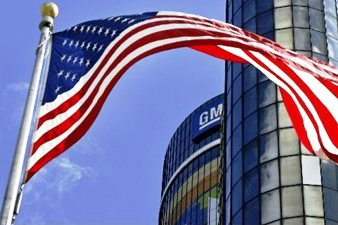 Detroit – Facing an automotive industry that is unsustainable in its current form, General Motors is restructuring its global vehicle portfolio, rethinking manufacturing and collaborating with unlikely partners to advance the industry.
Detroit – Facing an automotive industry that is unsustainable in its current form, General Motors is restructuring its global vehicle portfolio, rethinking manufacturing and collaborating with unlikely partners to advance the industry.
The company is working to transform transportation and describes its efforts in its latest Sustainability Report.
“Our customer focus underscores why sustainability is and will continue to be a core strategy for GM,” said GM CEO Mary Barra. “People care about more than the cars. They care how we build them, and how we engage with the world around us. This knowledge, and the discipline that flows from it, is transforming our approach to product design, manufacturing, safety, quality, the environment, customer care and a host of other areas at a remarkable pace.”
From smaller and cleaner high-performing engines to mass reduction and improved aerodynamics, vehicle efficiency efforts will reduce carbon emissions and increase fuel economy while meeting a variety of customer needs. The company now has five models achieving more than 40 miles per gallon.
GM progressed in all four of its product commitments in fuel economy, electrification and emissions reduction, and added another to tackle its biggest market. It has committed to reducing the average carbon emissions of its China fleet by 28 percent by 2020, which could result in an annual reduction of 2 million metric tons of CO2 and 1 billion liters of gasoline. GM has 153,034 electrified vehicles on the road as of 2013, moving along its path to reach 500,000 by 2017.
“Climate change, energy security, and congestion challenge our environment and our industry, but we see value in the disruption,” said Mike Robinson, GM Vice President, Sustainability and Global Regulatory Affairs. “We are reimagining transportation using a long-term, customer-centric approach.”
As more people expect their cars to have the technology they use everywhere else in their lives, GM satisfies connectivity demands while enabling a more sustainable transportation future. Customers in countries offering OnStar, including China, can use the service’s route optimization to find ways around congestion and receive real-time feedback on how to drive more efficiently. GM also is working toward a vision for connected vehicles that share information with each other and their infrastructure to help anticipate and avoid crashes.
“This innovation helps our products stay relevant and broadens the positive impact of a connected world,” Robinson said.
GM also is changing how cars are made to reduce the industry’s environmental footprint. The company is working to better understand the greenhouse gas impacts of its products throughout the supply chain so it can make broader improvements.
GM remains the only automaker signatory of the Climate Declaration, which asserts there is economic opportunity in addressing climate change. The company ranked among the top 10 percent of organizations that reported in the CDP Global 500 Climate Change Report 2013, demonstrating transparency in emissions and energy measurement and climate change strategy.
Last year, GM met the voluntary ENERGY STAR® Challenge for Industry criteria at nine additional plants for an industry-leading total of 63 facilities worldwide (including seven in China), saving $ 162 million in combined energy costs. From removing coal-fired boilers at its Detroit-Hamtramck assembly plant to saving $ 10 million in annual energy costs by using more landfill gas at its Fort Wayne and Orion assembly plants, GM is reducing its global carbon footprint, plant by plant.
GM and its communities continue to benefit from ongoing energy, water and waste reduction. Seven years ahead of schedule, the company met its commitments to reduce total waste and volatile organic compound emissions by 10 percent each and to establish 25 non-manufacturing landfill-free facilities. It will now set new targets.
In China, GM currently has 10 landfill-free facilities. Seven are operated by Shanghai GM and three by SAIC-GM-Wuling. These facilities – which include stamping, assembly and casting operations – reuse, recycle or convert to energy all manufacturing waste from their daily operations.
GM is improving the sustainability of its plants across China. For example, at an SGMW plant in Liuzhou they use no heating in winter other than in the paint shop to meet paint booth temperature and humidity requirements. Natural ventilation and harvested daylight make this one of the lowest energy plants in the world.
GM’s global manufacturing progress against other 2020 global manufacturing commitments with a 2010 baseline includes:
- Expanding renewable energy use to 66.2 megawatts, toward a goal of 125 megawatts
- Increasing the number of landfill-free manufacturing sites to 83, toward a goal of 100
- Reducing water intensity by 9 percent, with a goal of 15 percent
- Reducing energy intensity by 10 percent, with a goal of 20 percent
- Reducing carbon intensity by 7 percent, with a goal of 20 percent
“We like the results we are seeing, but we fully recognize we have a tremendous amount of work to do,” Barra said. “We must innovate more, seize opportunities faster and work harder to achieve true leadership – a claim that only matters if our customers, employees, communities and other stakeholders agree.”
Industry transformation will not come from one company’s actions alone. GM collaborates with unlikely partners, including competitors such as Honda to develop fuel cell systems and technology, and such non-governmental organizations as the BlueGreen Alliance, Union of Concerned Scientists, World Wildlife Fund and Ceres to create a greener economy and conserve the resources vital to the industry.
For more information on GM’s sustainability performance and to read/download the 2013 Global Sustainability Report, visit www.gmsustainability.com.
Source: GM.
General Motors Company, commonly known as GM, is an American multinational corporation headquartered in Detroit, Michigan that designs, manufactures, markets and distributes vehicles and vehicle parts and sells financial services. GM traces its roots back to 1908, and produces vehicles in 37 countries under ten brands: Chevrolet, Buick, GMC, Cadillac, Opel, Holden, Vauxhall, Wuling, Baojun, Jie Fang, UzDaewoo. General Motors employs 212,000 people and does business in 157 countries. More information on the company and its subsidiaries, including OnStar, a global leader in vehicle safety, security and information services, can be found at www.gm.com.














